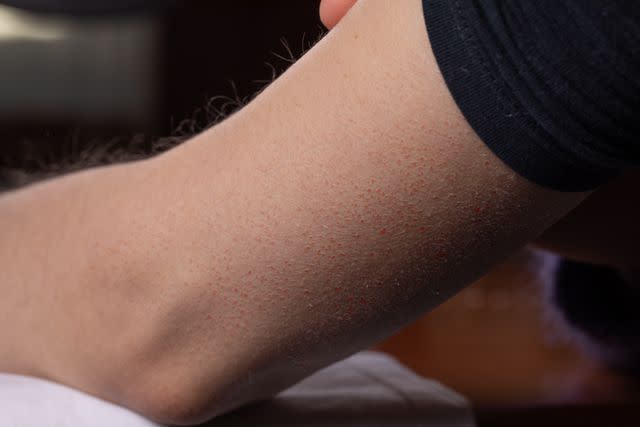Signs and Symptoms of Keratosis Pilaris

Eric Audras / Getty Images
Medically reviewed by William Truswell, MD
Keratosis pilaris (KP) is a common condition that causes small, rough bumps on your skin. These bumps develop when dead skin cells plug the pores (hair follicles). They can form anywhere on your skin but are most likely to appear on the upper arms, thighs, and cheeks. Keratosis pilaris, sometimes called “chicken skin,” is a benign (harmless) condition, but some people may feel self-conscious about the appearance or texture of their skin.
Symptoms of keratosis pilaris usually first appear during childhood before age two or in your teenage years. KP often fades over time by early adulthood but sometimes persists well into adulthood.
Symptoms often worsen during colder, drier months and improve in warmer, humid weather. You may notice bumps on your skin year-round if you live in an arid climate or have dry skin. Pregnancy and childbirth can also worsen symptoms.

sruilk / Getty Images
Common Symptoms
There are several types of keratosis pilaris. Although each type has distinct signs and symptoms, they share some characteristics. Common keratosis pilaris symptoms include:
Tiny, evenly-spaced bumps that appear grayish-white, pinkish-red, or brownish-black, depending on your skin tone
Dry, sandpaper-like skin
Skin with a texture similar to goosebumps or plucked chicken skin
Pruritis (itchiness)
Keratosis pilaris can develop anywhere on your body except the palms of your hands and soles of your feet. It's most common on the:
Upper arms
Front of the thighs
Cheeks (more common in children)
Buttocks
Keratosis Pilaris Rubra Symptoms
Keratosis pilaris rubra (KPR) is an inflammatory form of the condition that causes small, grainlike bumps and skin redness, primarily on the face, neck, chest, and arms. KPR symptoms often develop during childhood and may worsen or persist after puberty. Symptoms of KPR include:
Small, “grainlike” bumps
Skin flushing (redness), especially on cheeks
Itchiness
Burning sensations or skin discomfort
Keratosis Pilaris Alba Symptoms
Keratosis pilaris alba (KPA) is a milder form of KP that causes symptoms such as:
Dry, rough, sandpapery or scaly-feeling skin
Small, grayish-white bumps
Keratosis Pilaris Rubra Faciei Symptoms
Keratosis pilaris rubra faciei (KPRF) is a rare subtype that primarily affects the face. Symptoms include:
Pinkish-red, rough bumps on the face, especially cheeks
Pus-filled bumps that look like pimples
Facial flushing (redness) on the cheeks, forehead, and neck
Keratosis Pilaris Atrophicans Faciei Symptoms
Keratosis pilaris atrophicans faciei (KPAF) is a rare, hereditary subtype of keratosis pilaris. The onset of symptoms most commonly occurs in infancy and early childhood. They sometimes develop soon after birth and can last into adulthood.
KPRF is a progressive subtype of keratosis pilaris that causes the following symptoms:
Small bumps that first appear around the eyebrows
Facial flushing (redness)
Permanent alopecia (hair loss) on the edges of the eyebrows
Scarring in areas affected by hair loss that cause changes in skin texture
Small bumps and facial flushing can develop on the forehead, chin, and cheeks as the condition progresses. In most cases, people with KPAF also have widespread bumps on their arms, legs, chest, and back.
When to Contact a Healthcare Provider
Keratosis pilaris is a benign (harmless) condition that doesn’t require medical attention or treatment. However, you may want to visit a dermatologist if itchiness, dryness, or the appearance of your skin is bothersome. A dermatologist is a medical doctor who specializes in skin, hair, and nails.
Questions To Ask Your Provider
When you visit a dermatologist with keratosis pilaris symptoms, you may have questions about your possible diagnosis and treatment plan. Here are some questions to consider asking your provider:
Do I have keratosis pilaris, or could a different condition be causing these bumps?
Should I avoid certain foods to help get rid of the bumps?
Will my keratosis pilaris go away on its own or require treatment?
Is there a specific moisturizer you recommend to help keep my skin well-hydrated?
Can keratosis pilaris spread?
A Quick Review
Keratosis pilaris (KP) is a common skin condition that causes small, rough bumps on your upper arms, thighs, and cheeks. Different types of keratosis pilaris can cause varying symptoms. Some types cause rough, sandpaper-like bumps with skin flushing (redness), and others cause only rough, tiny bumps that blend in with your skin tone.
Keratosis pilaris symptoms usually develop in childhood or adolescence and often go away with time, but they can sometimes persist into adulthood. Symptoms can worsen in dry weather and when your skin is dry. It might also occur or get worse during or after pregnancy. Although keratosis pilaris is harmless, some people opt for treatment when the bumps cause itchiness or cosmetic concerns.
Frequently Asked Questions
What causes keratosis pilaris symptoms to flare up?
Keratosis pilaris symptoms can flare up when your skin is dry or becomes irritated from shaving or using soaps with irritating chemicals.
You can reduce keratosis pilaris symptoms by keeping your skin well-moisturized, bathing or showering in warm (not hot) water once a day, and using a humidifier in your home when the air is dry.
What is the fastest way to get rid of keratosis pilaris symptoms?
Gently exfoliating your skin with a loofah or rough washcloth, applying skincare products containing chemical exfoliators (e.g., alpha hydroxyl acid, glycolic acid, retinol, salicylic acid), and regularly moisturizing your skin with oil-free cream can help clear keratosis pilaris symptoms.
What food makes keratosis pilaris worse?
There is no specific keratosis pilaris diet or scientific evidence to suggest certain foods worsen symptoms. However, some anecdotal reports suggest that eliminating dairy and gluten may reduce symptoms.
For more Health.com news, make sure to sign up for our newsletter!
Read the original article on Health.com.

